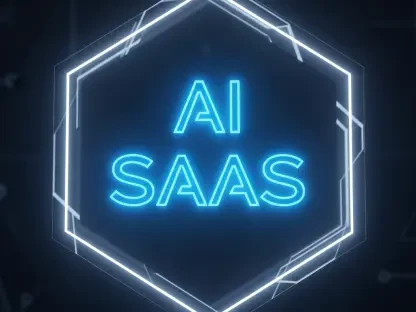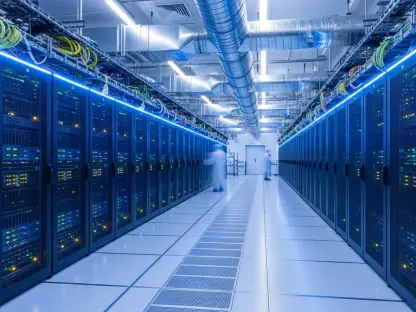I’m thrilled to sit down with Vijay Raina, a renowned expert in enterprise SaaS technology and software architecture. With his deep insights into cutting-edge tech and thought leadership in design, Vijay is the perfect person to unpack the complexities of AI infrastructure, data centers, and the future of cloud computing. Today, we’ll dive into the fascinating world of massive AI systems, global deployments, and the strategic role of established tech giants in the AI race. Let’s explore how these innovations are shaping the future of technology and what they mean for businesses and developers alike.
Can you paint a picture of what a massive AI system, often called an “AI factory,” looks like in terms of its hardware setup and overall capabilities?
Absolutely. Think of an AI factory as a colossal cluster of high-performance computing power, designed specifically for the intense demands of AI workloads. At its core, you’ve got thousands of cutting-edge GPU racks—imagine over 4,600 units equipped with something like the latest Nvidia Blackwell Ultra chips. These aren’t just powerful individually; they’re interconnected with ultra-fast networking technology, often something like Nvidia’s InfiniBand, which ensures seamless data flow between components. This setup allows the system to process massive datasets and train complex models at unprecedented speeds, making it a backbone for next-gen AI applications.
What role does advanced networking technology play in making these AI systems so effective?
Networking is the unsung hero in these setups. Technologies like InfiniBand are critical because they provide the low-latency, high-bandwidth connections needed to keep thousands of GPUs working in sync. Without this, you’d have bottlenecks—data wouldn’t move fast enough between processors, and the whole system would grind to a halt. It’s like having a superhighway for data, ensuring every component communicates efficiently, which is essential when you’re dealing with models that have hundreds of trillions of parameters.
When we talk about deploying hundreds of thousands of advanced GPUs worldwide, how do you envision the scale and timeline of such a rollout?
The scale is staggering. We’re talking about a global network of AI factories, potentially spanning dozens of countries in a matter of a few years. This isn’t just about slapping hardware into existing facilities; it’s a strategic build-out that requires planning for power, cooling, and connectivity. I’d expect a phased approach—starting with key regions that already have robust infrastructure, then expanding to emerging markets. The timeline could see initial deployments within a year or two, with full saturation taking closer to a decade as demand for AI compute skyrockets.
With an existing network of over 300 data centers across 34 countries, how does this kind of infrastructure provide a competitive edge in the AI landscape?
Having that many data centers already in place is a massive advantage. It means you’ve got the physical footprint to deploy AI systems quickly without starting from scratch. These facilities are already optimized for power, cooling, and security—key factors for AI workloads. Plus, their global spread allows for low-latency access to AI services across different regions, which is a huge plus for businesses needing real-time processing. It’s a head start that new entrants would struggle to match.
How do you see this kind of established infrastructure supporting the next wave of AI models with incredibly complex parameters?
These data centers are like launchpads for the future of AI. The next generation of models—with hundreds of trillions of parameters—will need insane amounts of compute power and storage. Existing infrastructure can be retrofitted or expanded to house AI factories, ensuring there’s capacity to train and run these models. More importantly, the geographic distribution helps with redundancy and resilience, so you’re not putting all your eggs in one basket. It’s about being ready for scale before the demand fully hits.
As partnerships in the AI space evolve, with some organizations building their own data centers, how do you think major cloud providers balance collaboration and competition?
It’s a tightrope walk. Cloud providers often see themselves as both partners and competitors to organizations building their own infrastructure. On one hand, they provide the compute power and services these groups rely on, fostering collaboration. On the other, they’re pushing their own AI agendas—developing proprietary models and tools. The balance comes from offering unmatched scalability and expertise while ensuring their own innovations don’t get overshadowed. It’s about creating ecosystems where everyone can grow, even if there’s underlying tension.
Looking at the long-term vision for AI factories within global cloud networks, what do you think the roadmap looks like for expansion and upgrades?
The roadmap likely focuses on both scale and efficiency. Expansion means building more AI factories in strategic locations to meet regional demand, while upgrades involve integrating newer, more powerful hardware as it becomes available. We’ll also see a push toward sustainability—think renewable energy sources for power-hungry systems. Over the next five to ten years, I expect these networks to become more modular, allowing for rapid swaps of tech to keep pace with AI advancements without overhauling entire facilities.
What challenges do you anticipate in scaling these AI systems to meet the growing demands of cutting-edge technology?
Scaling isn’t just about adding more hardware; it’s a multi-layered challenge. Power consumption is a huge hurdle—AI factories guzzle energy, and finding sustainable sources is critical. Then there’s the talent gap; you need skilled engineers to manage these systems at scale. Supply chain issues for GPUs and networking gear can also slow things down. And let’s not forget regulatory hurdles—different countries have different rules on data privacy and tech deployment. Overcoming these will require innovation, partnerships, and a lot of strategic planning.
What is your forecast for the future of AI infrastructure over the next decade?
I’m optimistic but realistic. Over the next ten years, I see AI infrastructure becoming more distributed and democratized—think smaller, edge-based AI factories closer to end users for faster processing. We’ll also witness a surge in hybrid models, where cloud and on-premises systems work seamlessly together. Energy efficiency will be a game-changer, with breakthroughs in cooling and power likely driving down costs. But the real shift will be accessibility—AI compute will become a utility, like electricity, available to startups and enterprises alike, fundamentally changing how innovation happens.









